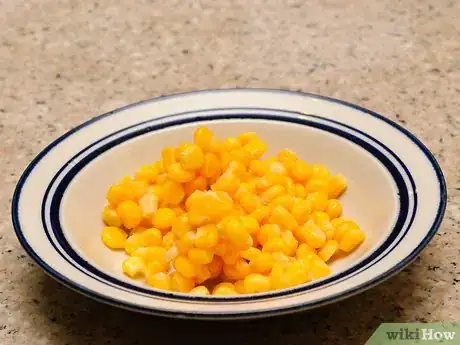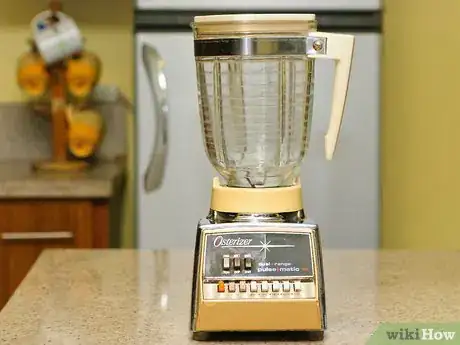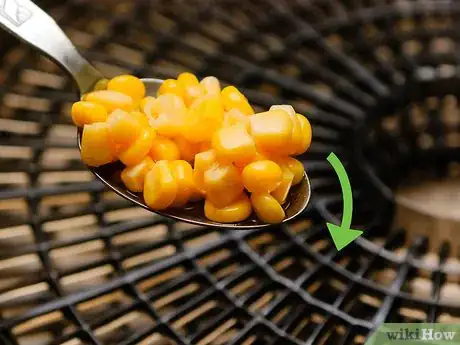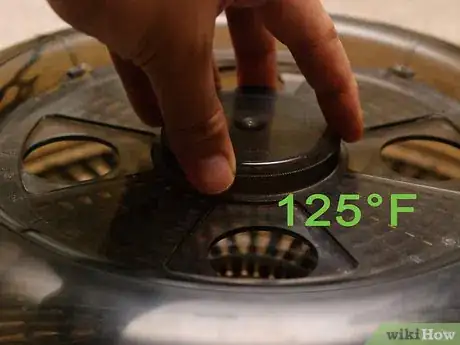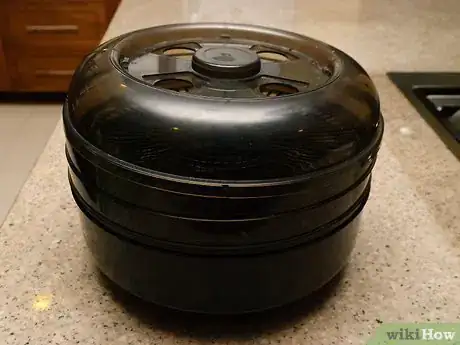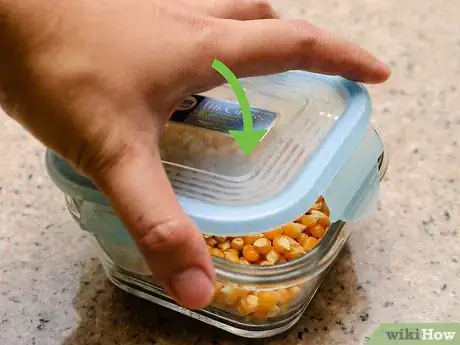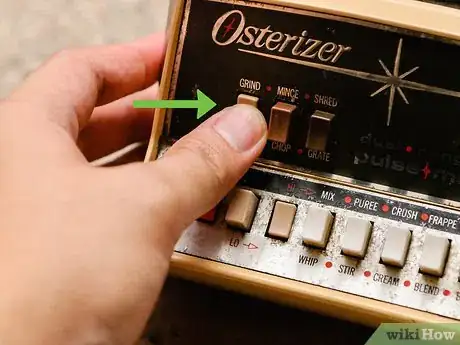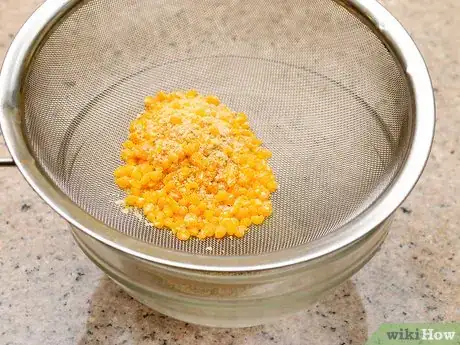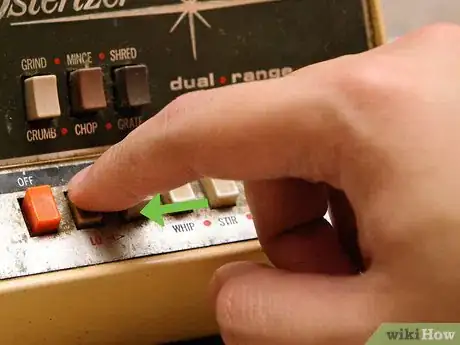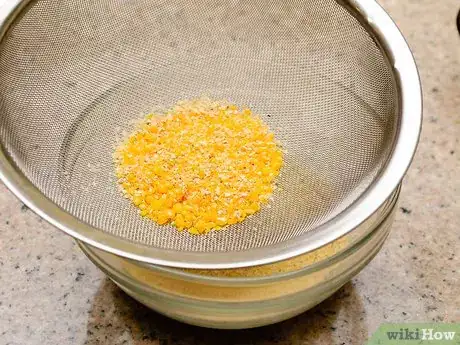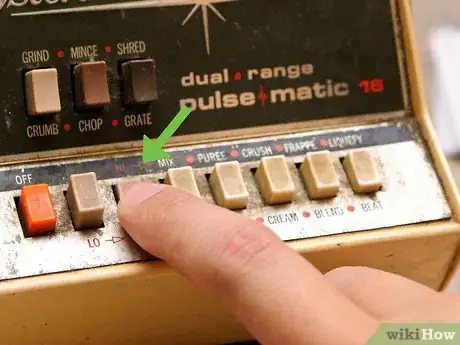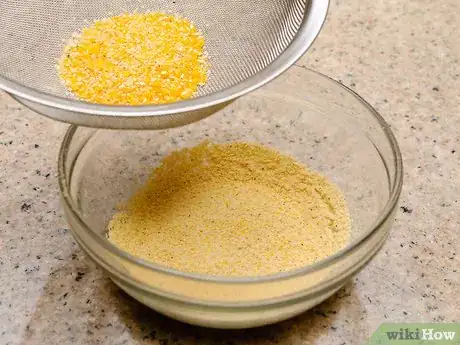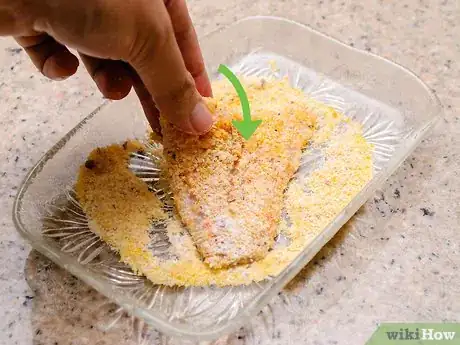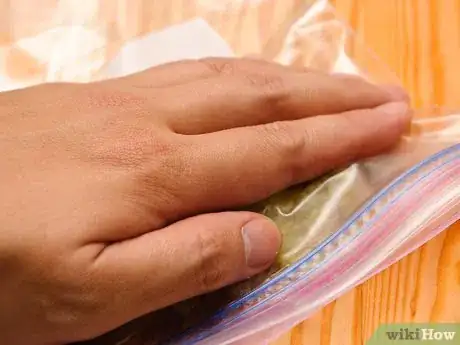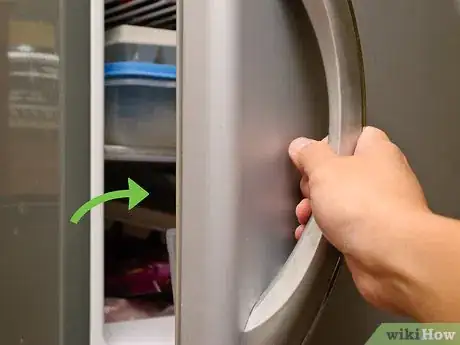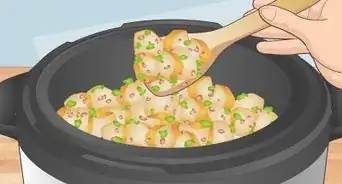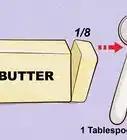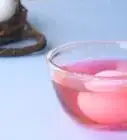This article was co-authored by wikiHow Staff. Our trained team of editors and researchers validate articles for accuracy and comprehensiveness. wikiHow's Content Management Team carefully monitors the work from our editorial staff to ensure that each article is backed by trusted research and meets our high quality standards.
There are 8 references cited in this article, which can be found at the bottom of the page.
This article has been viewed 58,778 times.
Learn more...
Cornmeal is a gritty and nutritious flour substitute that you can make at home. You can make your own cornmeal from dried whole corn kernels or unprocessed popcorn kernels. Homemade cornmeal will usually be less processed than store-bought versions, making it higher in nutritional quality and stronger in taste. You’ll need to dehydrate your corn using a dehydrator, and then repeatedly grind the corn using a grain mill or other grinding device.
Steps
Obtaining Corn and a Grinding Device
-
1Purchase corn from your local grocery store. Field or dent corn is the preferred variety for this method, but sweet corn could be used, as well. You can use nearly any type of corn; you’ll just need to properly and thoroughly dry the kernels. Visit a local supermarket, and peruse the different types of corn for sale. Or, purchase a variety that you already know tastes good.[1]
- If you’re using frozen corn from the grocery store, you’ll need 1 16-oz (450-g) bag of frozen whole kernel corn.
- You can also use nearly any variety of home-grown corn if you’re feeling more adventurous, but the process can be more time-consuming since you’ll need to dry it on the stalk.
- The easiest option, however, would be to use uncooked popcorn kernels. You won’t need to dehydrate popcorn, since it’s already adequately dry.
-
2Obtain a grain mill for grinding large amounts of corn. Electric and hand-operated grain mills are the probably your best options since they’ll allow you the greatest degree of control for your effort. Note that hand-operated grain mills may require considerable strength to use, especially when grinding something as large and coarse as corn.
- Purchase a grain mill at a large hardware store or through a major online retailer.
Advertisement -
3Purchase an electronic grinder for preparing smaller batches. If you don’t have an actual grain mill, high-powered blenders (Blendtec, Vitamix, etc.) may also work. Standard blenders are not strong enough to grind up dehydrated corn, and you should avoid using one for this process.[2]
- For preparing small amounts of cornmeal, you could also use a mortar and pestle, spice grinder, or coffee grinder.[3]
Dehydrating the Corn Kernels
-
1Spread the corn over the dehydrator tray. Open 1 16-oz (450-g) bag of frozen corn kernels. Spread the corn over one dehydrator tray, keeping it in an even layer. If you’re dehydrating fresh corn, shuck the ear, then use a sharp kitchen knife to slice the kernels off of the cob and into the dehydrator tray.[4] A large ear of corn should be the equivalent of 1 16-oz (450-g) bag.
- You can dry the corn directly from its frozen state. If some of the kernels are fixed together by ice, though, gently tap the chunks of corn on your counter or table to break them apart.
-
2Set the dehydrator to 125 °F (52 °C). Place the dehydrator tray into the dehydrator and set the temperature to begin drying out the corn.[5] Since the temperature needs to be so low, it’s really best to perform this process using an actual dehydrator rather than an oven.
- Most ovens will not reach low enough temperatures to dry the corn without cooking it.
-
3Dehydrate the corn for at least 8-12 hours. Check the corn kernels after 8 hours pass. Remove it from the dehydrator if it’s completely dry. Otherwise, continue dehydrating the corn as needed, checking it every 30 to 60 minutes.[6] To check the status of the corn, take a few kernels and try to manipulate them between your fingers. Properly dried kernels should no longer feel pliable.
- If the corn doesn’t feel pliable anymore, perform a second test by dropping a few kernels on a hard surface, like a counter or table. They should make a distinctive “click” sound when ready.[7]
-
4Put the dried corn into an airtight container if you don’t plan to grind it immediately. If you plan to make the cornmeal immediately, simply transfer the dehydrated corn to a medium mixing bowl and set it aside. Otherwise, place the corn into an airtight plastic bag or container. Resealable plastic bags work well enough if you plan to make cornmeal within a week or two, but for longer storage, use a canning jar or an airtight plastic container.[8]
- You can store the dry corn at in dry, dark, room temperature conditions if you plan to use it within a month. For longer storage, consider keeping it in your refrigerator or freezer.
Grinding the Corn into Cornmeal
-
1Grind the dried corn on the coarsest setting. Adjust the mill plates/stones to the machine’s coarsest setting. Grind batches of about 2 cups (170 g) of dehydrated corn. (When making larger quantities of cornmeal, you’ll need to grind multiple batches.) Place the dried corn into the hopper, then crank the handle to grind it through the machine. Make sure that you have a bowl or other container beneath the grain mill to collect the processed corn.
- The exact method for adjusting the mill plates will vary by machine, so you’ll need to consult the instructions for your grain mill to determine the proper procedure. Usually, though, you can adjust the coarseness using a knob on the side of the machine.
- If you’re grinding the corn with a mortar and pestle, fill the mortar halfway with corn. Use the pestle to grind the corn into small pieces by crushing the corn kernels on the sides and bottom of the mortar.
- When using an electric grain mill or a high-powered electric blender, you’ll need to switch on the power instead of turning a handle. With blenders, you can adjust the coarseness of the grind by selecting from different grind options on the base.
-
2Sift the coarsely-ground cornmeal. Dump the coarsely-ground cornmeal into a fine mesh strainer. Gently agitate the strainer from side to side to separate the finely ground pieces from the coarser chunks. Ideally, you should use a mesh strainer with gaps measuring between 1⁄16–1⁄32 inch (1.59–0.79 mm). Larger mesh strainers may pass pieces that are too coarse to be classified as meal.
- Collect the small pieces that pass through in a separate bowl placed beneath the strainer. Return the larger pieces caught in the strainer to the hopper of the grain mill.
-
3Grind the corn using a finer setting. Adjust the mill plates again, setting them to a medium-grade coarseness. Grind the large pieces of cracked corn through the mill as before. Once they’ve been ground at this setting, individual corn pieces should be about 1⁄8 inch (3.2 mm) in size.
- It’s important to change the coarseness to a finer setting during this step. Otherwise, the larger pieces won’t be ground down any further.
-
4Sift the product through the fine strainer a second time. Transfer the newly ground corn pieces back to the fine mesh strainer. Rock the strainer from side to side, allowing the finest pieces to pass through into the previous collection bowl for your cornmeal.
- You’ll likely collect more cornmeal during this sifting than you collected during the first, but in most cases, you’ll still be left with a notable amount of coarse grain caught in strainer.
-
5Grind the corn a final time on an even finer setting. Adjust the grain mill once more, setting the machine to medium-fine consistency. Return the pieces of ground corn that are still in the strainer to the hopper, then grind them through the machine a third time. As with previous rounds through the grinder, catch all of the
- While the machine needs to be set to a finer degree of coarseness, you’ll probably need to avoid using the finest setting. Even at cornmeal consistency, ground corn can be too coarse to pass through most mills’ finest setting.
-
6Separate the remaining meal from the grits. Sift the ground corn through the mesh strainer one more time, collecting the fine meal in your original bowl and retaining the coarser grits in the strainer itself. The grits will be the remnants of dehydrated corn that are too coarse to pass through the fine sifter.
- At this point, you should have more cornmeal than leftover grits, and the amount of cornmeal should roughly match the original amount of dried corn you began with.
- If you’re still not satisfied with the amount of cornmeal produced, you can pass the coarse grits through your grain mill one more time. Afterward, sift them again using the mesh strainer. The amount of cornmeal produced by a fourth pass will likely be less than the amount produced by the previous two passes.
- Beyond a fourth pass, additional passes through the grain mill may become even less beneficial.
Using and Storing the Cornmeal
-
1Cook with the cornmeal immediately after making it if desired. Using the cornmeal the same day or the next day will allow you to retain the maximum amount of nutrients and flavor. Use the cornmeal or the grits that you saved to make grits, cornbread, or Johnny cakes.
- You can also use homemade cornmeal in any recipe calling for cornmeal, including cornmeal mush and cornmeal-based fish batter.
-
2Seal the cornmeal in plastic bags if you’ll use it within several months. This should prevent it from turning rancid.[9] Place the cornmeal in a heavy-duty resealable plastic bag. Press out as much air as possible, then seal the bag, leaving only 1 inch (2.5 cm) of open space along the seal.
- Suck out the remaining air through a straw inserted into the opening. Do this step carefully to avoid accidentally inhaling bits of cornmeal. When finished, quickly remove the straw and seal the remainder of the opening.
- Sealed bags of cornmeal can be stored in dark, dry, slightly cool conditions for up to 12 months.[10]
-
3Freeze leftover cornmeal if you’re not going to cook with it for a year. Cornmeal you don’t plan to use immediately can be transferred into freezer-safe containers and stored in your freezer. Pack the cornmeal into an appropriate jar or other container, leaving about 1⁄2 inch (1.3 cm) of empty headspace. Close the jar and place it into your freezer, storing it there for as long as 24 months.[11]
- You can use the cornmeal directly from the freezer without thawing it. If you’re making a temperature-sensitive recipe, thaw the cornmeal at room temperature for 30-60 minutes before use.
Community Q&A
-
QuestionWait, so when I switch to a finer setting, I put in fresh corn or fresh corn AND what I've already collected?
 Jo BriggsCommunity AnswerJust the leftover corn (the grit) in your sifter should be put back into the grinder (or blender) again. The "grit" is the larger corn pieces left over in your sifter. The "cornmeal" is the finely ground corn that has gone through the sifter and is now in the bowl. You can use the leftover grit in another recipe.
Jo BriggsCommunity AnswerJust the leftover corn (the grit) in your sifter should be put back into the grinder (or blender) again. The "grit" is the larger corn pieces left over in your sifter. The "cornmeal" is the finely ground corn that has gone through the sifter and is now in the bowl. You can use the leftover grit in another recipe. -
QuestionWhat can be used as a substitute for a dehydrator?
 DenFrenCommunity AnswerPut the corn in an oven at around 115. You can keep an eye on it until they dry out, could be an hour or two.
DenFrenCommunity AnswerPut the corn in an oven at around 115. You can keep an eye on it until they dry out, could be an hour or two.
Things You’ll Need
- Sharp kitchen knife
- Dehydrator
- Dehydrator tray
- Medium mixing bowl
- Grain mill or high-powered blender
- Mortar and pestle (optional)
- Fine mesh strainer with mesh between 1⁄32 inch (0.79 mm) and 1⁄16 inch (1.6 mm)
- 3 medium bowls
- Airtight jars
- Resealable plastic bags (optional)
References
- ↑ http://momwithaprep.com/make-your-own-cornmeal/
- ↑ http://www.blenderbabes.com/baking-recipes/how-to-make-cornmeal/
- ↑ http://www.seriouseats.com/2013/03/diy-cornmeal-from-popcorn.html
- ↑ https://selfreliantschool.com/dehydrate-corn-tips-cutting-cob/
- ↑ http://momwithaprep.com/how-to-dehydrate-frozen-vegetables/
- ↑ https://selfreliantschool.com/dehydrate-corn-tips-cutting-cob/
- ↑ http://www.barefeetinthekitchen.com/2011/06/dehydrated-corn-and-green-beans.html
- ↑ https://selfreliantschool.com/dehydrate-corn-tips-cutting-cob/
- ↑ https://www.eatbydate.com/other/baking/cornmeal/
About This Article
To make your own cornmeal, you’ll need dried corn kernels and an electric or hand-operated grain mill. If you can’t find a grain mill, a high-powered blender might work. Pre-dried popping corn is a great option for making cornmeal, but you can also dry out fresh corn kernels for 8-12 hours in a dehydrator set to 125 °F (52 °C). Set your grain mill or high-powered blender to the coarsest setting and grind the corn in batches of about 2 cups (170 g) at a time. Pour the ground corn through a fine metal sieve into another container, then put the larger pieces that remain in the sieve back into the mill and grind them again on a finer setting. Repeat this process one or two more times, setting the mill to a finer setting each time. By the third or fourth pass through the mill, most of the corn will be ground into a fine meal that can fit through the sieve, but you’ll still have some larger pieces (grits) left over. If you don’t plan to use the cornmeal right away, store it in sealed jars or plastic bags in a cool, dry place for up to 12 months. You can also store cornmeal in the freezer for up to 24 months. To learn how to dehydrate sweet corn to make cornmeal, read on!
